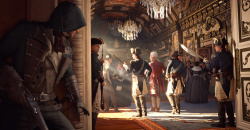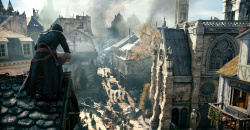Assassin’s Creed Unity is the first game in the series to appear exclusively for the latest generation of consoles. You can experience the adventure on Windows, PlayStation 4, and Xbox One – Xbox 360 and PlayStation 3 owners are out of luck this time, however. This test is based on the Xbox One version.
Vive la révolution!
Arno Victor Dorian was born at Versailles in 1768, the son of a French father and an Austrian mother. He lived at the palace until his father was murdered, after which he was taken into the family of his childhood friend Élise de la Serre. Now the year is 1789 – the French Revolution rages on the streets of Paris, and everywhere fear and terror reign. One day Arno’s adoptive father Francois de la Serre is murdered, and Arno is accused of the crime and brought to the Bastille. There he meets the assassin Pierre Bellec, who recognizes that Arno, too, possesses the right talents to be an assassin. At just the right moment, the storming of the Bastille begins, and both inmates use the opportunity to flee the prison. Before they part ways, however, Bellec offers Arno the chance to join the Brotherhood of Assassins.
Arno takes him up on his offer and seeks to use the Brotherhood’s help to get to the bottom of his adoptive father’s murder. Assassin’s Creed Unity allows you to be present at historical events such as the execution of Louis XVI and the September Massacre, and meet such important personalities as Robespierre and Napoleon Bonaparte. The game is a good opportunity to learn a bit about the events of the French Revolution, and will probably even get those who are interested in history to go and read up about the stuff not covered in the game. The game does a good job of getting the general feel of the era across to the player, as the next-gen graphics allow for more realistic detail than ever before.
Paris, City of Love
Assassin’s Creed Unity was developed using a revamped version of Ubisoft’s Anvil engine, AnvilNext, which allows for an entirely new level of graphical depth and detail in depicting Paris in the late 18th century. At least in theory, as we won’t really get to see this in practice until Ubisoft has managed to release all the patches needed to iron out the several troublesome bugs that exist in the current version of the game. The fist two updates were released while we were testing the game, but things aren’t running as smoothly as they should just yet. We kept getting all kinds of frame rate problems, textures that took too long to load, unintentional ragdoll effects on enemy bodies, as well as several other assorted bugs. These issues really mess up the overall impression of the game, but Ubisoft is already working hard on more patches. It’s a real shame that they couldn’t give us a satisfactory product on the actual release date itself, or that they didn’t consider delaying the release until they could get some of these problems fixed.
But even with all the bugs, it’s clear how much detail Ubisoft put into modeling Paris, and the city itself is the real star of the game. When you compare the buildings in the game with the buildings that still exist in real life, it’s clear that they resemble one another down to the tiniest detail. This is especially apparent in the case of Notre Dame Cathedral. Ubisoft claims they took a total of 14 months and 5000 man-hours to research and model the cathedral, which consists of 3 million polygons in the game and features 140 replicated stained glass windows. You can climb all over the building and look at the water spouts up close, scale the flying buttresses, and admire the religious statuary. There are also many other historical buildings such as the Louvre, the Hôtel de Ville, and the Sorbonne. Each individual part of the city has its own design and special feel, and you can go from slums full of beggars and other miserable souls to neighborhoods made up of the grandiose villas of Parisian aristocrats. If you look closely enough, you’ll even see pamphlets and street signs on the walls.
The city’s buildings aren’t the only things that have been able to profit from the new graphics engine. The city is also teeming with life, and when you stand on the Champs-Élysées watching hundreds of people shouting or chanting slogans at the same time, it’s pretty impressive. The residents of Paris interact with one another as they go about their daily business. Watch closely and you’ll see quarrels breaking out, merchants taking care of their stalls, and people singing and talking with each other in the taverns. This is also where another positive aspect of the game comes to bear, as Assassin’s Creed Unity features excellent sound design and great voiceovers, all of which help to add depth to the game’s atmosphere.
Nothing is true, everything is permitted
The main character Arno Dorian develops step by step into a true assassin skilled in the use of a variety of weapons suited to his trade. Naturally, this includes the famous Hidden Blade, in this game the Phantom Blade, which includes retractable crossbow arms and can fire berserk darts and lethal darts. Arno can also use swords, pistols, rifles, and polearms. Earn enough francs and you can buy better and better weapons as well as clothing to customize Arno according to your own particular style.
You also receive sync points for completing missions, which allow you to upgrade Arno’s skills and attributes in an RPG-style system that lets you increase his health, lock-picking skills, ranged weapons skills, or his ability to blend in with his environment – the kinds of things that assassins in previous games would unlock in the course of the game.
One important aspect of all Assassin’s Creed games is the freedom of movement afforded to players. Parkour mechanics have been revamped in Assassin’s Creed Unity, allowing for smooth and fluid movement climbing on walls and rooftops and sliding under obstacles. You can also now slip into open windows and doors to explore buildings or use them as shortcuts. One thing you’ll notice here, however, is that a lot of the interiors are very similar.
Arno moves more fluidly through his surroundings and looks cooler than his predecessors in previous Assassin’s Creed games. There are also now separate Ascend and Descend buttons, allowing you more control while moving vertically through the city, with fewer unintentional suicidal leaps. Of course, they haven’t done away with all the problems with the controls either – sometimes you press a button and the game interprets it incorrectly, or Arno just won’t do what you want him to. This doesn’t happen very often, true, but it’s really annoying every time it does happen.
Stealth like a master assassin
You don’t just have freedom of movement when exploring Paris – on most missions you can decide for yourself how you want t go about doing things. You’re given a clear objective, but it’s up to you to decide how you want to use your surroundings, or if you want to use stealth or not. There are usually helpful secondary objectives that make the missions somewhat easier, but you don’t actually have to complete these, either. Stealth gameplay in Assassin’s Creed Unity is an even more important part of the gameplay than was the case in previous games. For example, you can use your surroundings to hide in a hay cart or a shed, using it to ambush one of your marks. You can also disappear into the crowd in order to get into a building right in front of your enemies’ eyes. Arno can also now hide behind various objects and use them for cover. Sometimes it’s also a good idea to simply flee the scene of your actions, too. If your pursuers lose sight of you, they’ll look for you near the last place they saw you, which will be marked with Arno’s silhouette. You can then use this opportunity to disappear into the shadows or to launch a new attack and catch your enemies unawares.
The combat system, which was relatively simple in previous Assassin’s Creed Games, has been expanded upon in Unity and now offers a greater challenge. While the system still consists of the three basic principles attack, dodge, and counter, enemies now take more hits to kill, counter-kill moves have been removed, and Arno will be able to absorb less damage than his predecessors.
Arno, a very busy man
Whether you follow the main storyline, complete one of the numerous side missions, or spend your time hunting for various collectible objects, Ubisoft leaves you a ton of choices for things to do in this game. It takes about 15-20 hours to complete the main storyline, and the side missions add a few more hours to that. These side missions are usually pretty interesting – they include Nostradamus Enigmas, which are a series of riddles where you have to find different locations throughout Paris, each of which contains a symbol that unlocks the next Enigma. The various Murder Mysteries are also really interesting, requiring you to you to investigate the crimes scene and question witnesses in order to combine this information to determine who the culprit is and track them down.
There are also several collectible objects like chests, cockades, and artifacts. However, the reward for finding these objects is usually so insignificant that there’s really no incentive to spend much time looking for them. If you’re trying to get all the achievements or trophies, maybe then it might be worth your time, though you’d better go ahead and get the Assassin’s Creed companion app for your smartphone and set up an “Initiates” account, since you can only open some chests in the game after you’ve made some progress with the app.
Never-ending (hi)story
Another really interesting feature is that you can enter Helix Rifts, which allow Arno to access various other eras in history. Arno can travel to the Belle Époque of Paris at the end of the 19th century, or get caught up in the occupation of Paris by the Nazis in World War II. The storyline will have already taken you to both eras, but while the main story had you do some interesting acrobatics there, in the side missions you have to collect colored data clusters in order to recue other assassins stuck in the Helix Rifts, while tornados and search lights make things more difficult. These missions are a lot of fun at first, but after repeating them once or twice they tend to become a lot less motivating, and start to feel monotonous in their design.
The Encyclopedia is once more an entertaining feature in this latest Assassin’s Creed game. You can use it to read all kinds of interesting things about characters, events, and locations that serve to expand the Assassin’s Creed universe and allow a more complete picture of the historical circumstances portrayed in the game. If you go ahead and google the facts found in the Encyclopedia, you’ll see just how serious Ubisoft was about doing their research. Various characters that you assist in the side missions are actual figures taken right out of French history. Henri Masers de Latude, for example, was known for his numerous successful escapes from the Bastille and the donjon at Château de Vicennes. He was able to accomplish one of these breakouts with the help of a rope ladder, and the game has Arno steal this very rope ladder from the Bastille.
Murder by numbers
Assassin’s Creed fans have long asked for a co-op mode, and Ubisoft has given them what they wanted in Assassin’s Creed Unity. Now up to four players can terrorize the streets of Paris together, though only online and not via split-screen on a single console. The co-op missions, which parallel the single-player campaign, have been specifically designed so that assassins will have to work together to take out various targets throughout the city. You play using the same character you use in the single-player game, including the skills and weapons this character possesses. You can also choose one of four co-op skills in order to help out your team, and each member should use their individual talents to assist their teammates in the best way possible. For example, if you’ve specialized in Eagle Sense, you should be the team’s scout. Or if you’ve focused on melee or ranged combat, you should use those skills in combat.
Aside from the missions there are heists, where you work together with your comrades to secure chests in areas in the possession of your enemies. The reward is greatest when you manage to get to the chest completely undetected. The missions are pretty entertaining, but they’re not as original as many of the single-player missions. Heists are really only for those who enjoy stealth and have a lot of patience. They also require a great deal of teamwork, and if each player does their own thing, you’re going to have very little chance of success. This means everyone is going to have to plan their actions wisely and discuss them with their teammates if they want to be able to discover new gameplay options and master the more difficult missions. Of course this means it’s best to play with people you know, since most people have an easier time communicating with friends than strangers. Still, if you play with random players over Xbox Live you should still be able to complete the missions, as long as each teammate makes an active contribution and sticks to the task they’ve been given.


















plz send me the xbox code to